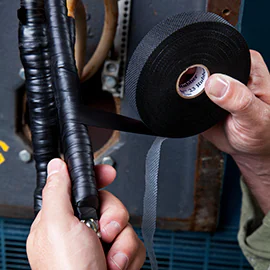The Versatility and Applications of Butyl Gum Tape
Butyl gum tape is a specialized adhesive tape that has gained popularity across a wide range of industries due to its unique properties and versatile applications. Composed of butyl rubber, this tape is known for its exceptional adhesion, flexibility, and resistance to weather and moisture. With these qualities, butyl gum tape serves various purposes, from construction and automotive to marine and aerospace sectors.
One of the most significant advantages of butyl gum tape is its strong bonding capability. Butyl rubber has outstanding adhesive properties, allowing it to adhere effectively to various surfaces, including metals, wood, glass, and plastics. This quality makes it an ideal choice for sealing joints, gaps, and seams where a durable and weather-resistant bond is required. In construction, for example, it is commonly used for roofing applications, window sealing, and vapor barrier installations. The tape's ability to create a watertight seal helps prevent leaks and moisture damage, contributing to the longevity of buildings.
Moreover, butyl gum tape is widely employed in the automotive industry. Its flexibility and durability allow it to be used in a variety of applications, including sound dampening, vibration reduction, and sealing in automotive assemblies. It is particularly useful in areas prone to weather exposure, providing an effective barrier against water and dust infiltration. In vehicle manufacturing, using butyl gum tape can enhance overall performance by ensuring a tighter fit of components, thereby reducing the risk of rattling and improving insulation.
The marine industry also benefits significantly from butyl gum tape
. Boats and yachts require reliable sealing materials to protect against the harsh marine environment, where exposure to saltwater and humidity can lead to corrosion and damage. Butyl gum tape's waterproof properties and excellent adhesion to fiberglass and metal surfaces make it an ideal choice for sealing hatches, windows, and deck fittings. Many boat builders and marine repair professionals rely on this tape to ensure that their vessels remain watertight and structurally sound.butyl gum tape

In addition to its applications in construction, automotive, and marine industries, butyl gum tape finds its place in the aerospace sector as well. The rigorous standards in aviation demand high-performance materials, and butyl gum tape meets such demands through its ability to withstand extreme temperatures and pressures. It is utilized in aircraft assembly and maintenance for sealing and insulating various components. The lightweight nature of butyl gum tape also contributes to overall weight reduction in aircraft, which is crucial for fuel efficiency.
Notably, butyl gum tape is also an eco-friendly option compared to many other adhesive products. Many manufacturers produce it without the use of harmful solvents, making it a safer choice for both users and the environment. Additionally, butyl gum tape is known for its durability, which reduces the need for frequent replacements, minimizing waste over time.
Despite its many advantages, it is essential to use butyl gum tape correctly to achieve optimal results. Proper surface preparation is crucial for ensuring that the tape adheres effectively. The surfaces should be clean, dry, and free from contaminants. When applying butyl gum tape, it is also advisable to press firmly to ensure good contact with the surface. Following these best practices can maximize the tape's performance and extend the life of the bond.
In conclusion, butyl gum tape is a remarkable material that offers extensive applications across various industries due to its superior adhesion, flexibility, and resistance to moisture and environmental factors. Whether in construction, automotive, marine, or aerospace, its ability to create strong, durable bonds makes it an invaluable tool for professionals. As industries continue to evolve, the reliance on innovative adhesive solutions like butyl gum tape will only grow, affirming its place as a vital resource in modern manufacturing and repair processes.
-
XIANGFAN Rubber Tape-Ultimate Solutions for All Your Insulation NeedsNewsJun.24,2025
-
XIANGFAN Rubber Tape-Protection for Industrial and Residential ApplicationsNewsJun.24,2025
-
XIANGFAN Rubber Tape: Superior Safety and Sealing for Demanding EnvironmentsNewsJun.24,2025
-
XIANGFAN Rubber Tape: Reliable Solutions for Every Electrical ChallengeNewsJun.24,2025
-
XIANGFAN Electrical & Industrial Tape: Powering Reliability Across IndustriesNewsJun.24,2025
-
XIANGFAN Electrical & Industrial Tape: Excellence in Every ApplicationNewsJun.24,2025
